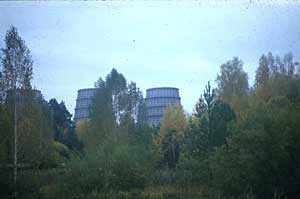
New Managing Director for Bellona Norway
The Board of the Bellona Foundation has appointed former Minister of Climate and the Environment Sveinung Rotevatn as Managing Director of Bellona No...
News

Publish date: April 11, 2000
Written by: Thomas Nilsen
News
The surprising February proposal by the Russian Ministry of Nuclear Energy to close down the three Siberian plutonium producing reactors and replace them with an alternative energy source would not last for long. When U.S. officials came to Moscow in late March they thought they would discuss the idea of building new fossil fuel energy sources, but were instead confronted with a new proposal to keep the reactors in operation for another 20 years. This time the proposal is based on a new technical study to convert the reactors to operate with a different type of low-enriched uranium, writes the U.S. newsletter Post-Soviet Nuclear & Defence Monitor.
The reactors in question are the three remaining military RBMK reactors – two in Seversk and one in Zheleznogorsk – that have been for more than 30 years the core part of the plutonium production for nuclear warheads in the Soviet Union. A halt in the plutonium production has been a common goal for the post-Cold War agreements between the United States and Russia. But since these reactors also serve as a local heat and electricity source for the nearby settlements, it has been out of question for the Russian negotiators to just stop them without any alternatives.
The first proposal in the joint U.S. – Russian discussions was to convert the reactor cores to be fuelled with high enriched uranium, preventing the spent fuel to contain weapons grade plutonium after reprocessing. The proposal was heavily protested by the Russian State Nuclear Regulatory, GAN, which claimed that such alternative would pose a far-to-high safety risk for the ageing reactors. To meet some of the critics, the new proposal includes a 20 percent power reduction during the reactors operation. Reduced power leads to less heat generating and therefor less chances of the reactors’ graphite blocks of swelling. The reactors are in principal of the same design as the Chernobyl reactor that blew up in 1986, but far older.
Yuri Vishnevsky, the head of GAN, said earlier that the ageing Seversk reactors had already twice exceeded their service lifetime and the safety risks posed by the continued operation were rather obvious. Vishnevsky has the first hand knowledge on this topic, he participated in the design and construction phase of the RBMK reactors. GAN has so far not commented on the latest proposal from Minatom to convert to low-enriched uranium and continued operation for another 15 years after the conversion period that would last for five years. Most likely, Minatom has not yet informed the civilian inspectors, adding another stone to the problematic relationship between the two strugglers on the Russian nuclear arena.
In compliance with the U.S. – Russian agreement to halt the plutonium production, the U.S. side was through its CTR program obliged to help building of fossil-fuel substitutes for the reactors. This agreement was renegotiated in 1996 to instead convert the reactors’ cores. But, revived in February this year the fossil-fuel option was said to be far much cheaper than earlier estimated and therefor again considered being the right solution. That lasted for less than two months.
"One can only guess why core convention is again proposed by Minatom. We think they (Minatom) have figured out that the fossil-fuel option would not create any jobs for their ministry," says Konstantin Kozlov, local activist in the Tomsk Ecological Student Institute. The city of Tomsk is just some few kilometres from the closed nuclear city of Seversk. In Seversk, the majority of the population works at the Minatom nuclear industrial sites, for decades kept secret for the surrounding society.
Quoted by Post-Soviet Nuclear & Defence Monitor, an unnamed U.S. official said the final review of the new proposal will be presented to the Americans at another Moscow meeting to be held on April 12-13.

The Board of the Bellona Foundation has appointed former Minister of Climate and the Environment Sveinung Rotevatn as Managing Director of Bellona No...

Økokrim, Norway’s authority for investigating and prosecuting economic and environmental crime, has imposed a record fine on Equinor following a comp...

Our op-ed originally appeared in The Moscow Times. For more than three decades, Russia has been burdened with the remains of the Soviet ...

The United Nation’s COP30 global climate negotiations in Belém, Brazil ended this weekend with a watered-down resolution that failed to halt deforest...